-
Discover new ways to elevate your game with the updated DGCourseReview app!
It's entirely free and enhanced with features shaped by user feedback to ensure your best experience on the course. (App Store or Google Play)
You are using an out of date browser. It may not display this or other websites correctly.
You should upgrade or use an alternative browser.
You should upgrade or use an alternative browser.
The Kinetic Sequence
- Thread starter sidewinder22
- Start date
- Joined
- Aug 16, 2014
- Messages
- 1,680
This video finally helped me to understand just how soon the deceleration starts and how posting up initiates "braking". He starts talking about it here but the whole video is good.
https://youtu.be/K6OA8UGq3FI?t=265
By decelerating earlier and posting up I'm really starting to get the feel of the SW22's Tilted Twirl Star Burst starting here https://youtu.be/k4-IN1yMQXc?t=385
https://youtu.be/K6OA8UGq3FI?t=265
By decelerating earlier and posting up I'm really starting to get the feel of the SW22's Tilted Twirl Star Burst starting here https://youtu.be/k4-IN1yMQXc?t=385
Flashblastx
Par Member
- Joined
- Sep 12, 2020
- Messages
- 106
This video was pretty cool to see how different these two swing and how patience really develops power. In another video Kyle immediately knows how to increase Bryson's speed, he is very aware how how to accelerate. Look at that early push off the ground... goals.
- Joined
- Nov 2, 2008
- Messages
- 22,031
Your hand should pull you into the followthru.Would the follow-through be the next step after this? I think this is something major I've been missing. I've always tried to be smooth, but it sounds like there should be an intentional firming up of the front leg muscles to stop everything?


- Joined
- Aug 16, 2014
- Messages
- 1,680
A good explanation of how correct body positions produce speed by limiting rotation to create automatic braking to allow arms and hands to accelerate. Also demonstrates why the tilted spiral is so effective/efficient for the throw because it limits rotation.
- Joined
- Nov 2, 2008
- Messages
- 22,031
Some rambling...
Awesome description of basically what happens in the hop and throw from 17-20min in pbs link, total body tendon bounce and piston compression action. You exhale going into the hop, then inhale airborne(I often stick my tongue out a la Jordan) and everything is totally relaxed and free wheeling and falling while airborne and the pelvis is free to pivot back while moving or gliding over the rear leg without breaking stride/slowing down and then you load back forward leveraged into the rear leg/foot resisting collapsing and spring into the plant exhaling and compressing against the ground.
http://www.pbs.org/wnet/nature/equus-story-of-the-horse-episode-1-origins/17063/
It is the rear foot plantar flexion tendon bounce/recoil that throws the rear leg forward after accelerating your center of gravity/pelvis. There is no bounce when you let your posture collapse and are flat footed/dorsiflexed/pushing off the heel and trying to extend the slower rear knee and hip. You need to be resisting the rear leg collapsing posture and spring off the flexed foot. If you try to lean back or are turned back early and load, then you can't spring forward dynamically centered, but you can tip or throw the upper body back over top the front side and leave your weight back on the rear foot.
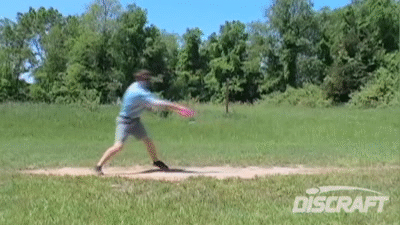
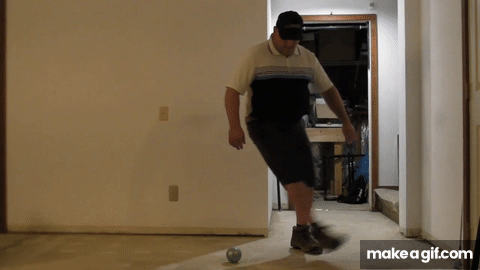


The front foot plants plantar flexed and then suddenly drops the heel crushing the can and trapping the tendon bounce and ground reaction force transfers that elastic energy up the body and out to the arm/disc instead of the foot perpetuating the hop.
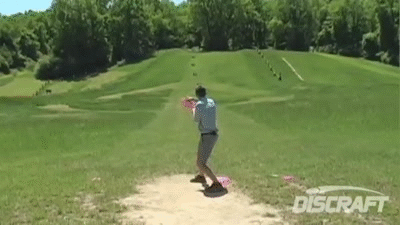
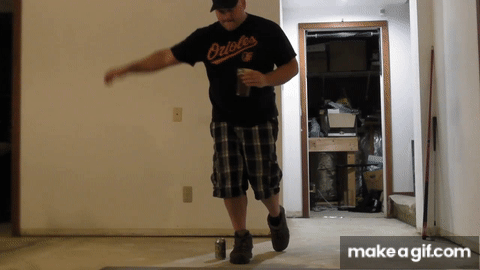
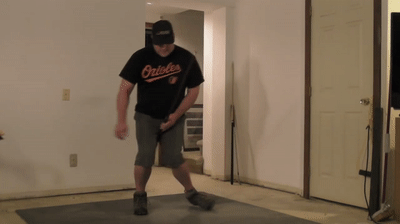
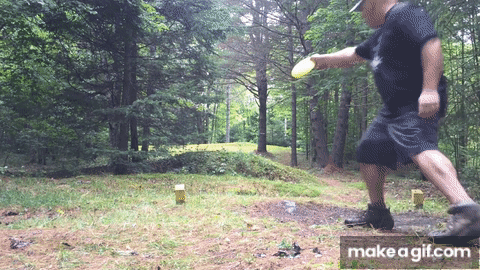
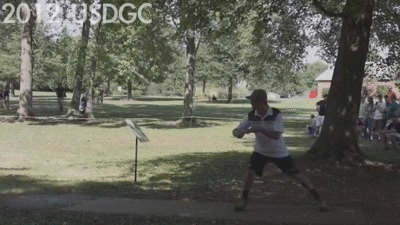
- Joined
- Aug 16, 2014
- Messages
- 1,680
Like most of your teaching, SW, this makes a lot more sense to me a year or two later when I have a better understanding of what is really going on.
I bet the squirrels in my back yard would be a match for a kangaroo for elastic energy and tendon bounce.
- Joined
- Aug 16, 2014
- Messages
- 1,680
"The swing is over earlier than you think!" The application of force/leverage really ends early to allow the transfer of energy. If you continue to apply force late you regenerate lag by getting ahead of the swing. See SW22's post #39 above for the graphics of the rotational and linear kinematic sequence.
- Joined
- Aug 16, 2014
- Messages
- 1,680
Parbequeue
Eagle Member
It's the ball on string training tool! Really awesome.
azplaya25
Double Eagle Member
- Joined
- Aug 8, 2019
- Messages
- 1,243
Three drills for sequencing the swing.
Fantastic video!
Found this in my journey down the YouTube rabbit hole. First time I've ever seen a golf pro use a frisbee for a drill!
https://youtu.be/D1dIztRfaYU
seedlings
* Ace Member *
Fantastic video!
Found this in my journey down the YouTube rabbit hole. First time I've ever seen a golf pro use a frisbee for a drill!
https://youtu.be/D1dIztRfaYU
I feel like some unspoken rules might have been violated and this instructor will be reprimanded, lol... seriously though, nice tip to have the inside of the elbow toward the target (even in disc golf).
Attachments
- Joined
- Nov 2, 2008
- Messages
- 22,031
Fantastic video!
Found this in my journey down the YouTube rabbit hole. First time I've ever seen a golf pro use a frisbee for a drill!
https://youtu.be/D1dIztRfaYU
In disc golf "elbow in" is a myth or t-rex arm as Scott Stokely calls it.I feel like some unspoken rules might have been violated and this instructor will be reprimanded, lol... seriously though, nice tip to have the inside of the elbow toward the target (even in disc golf).

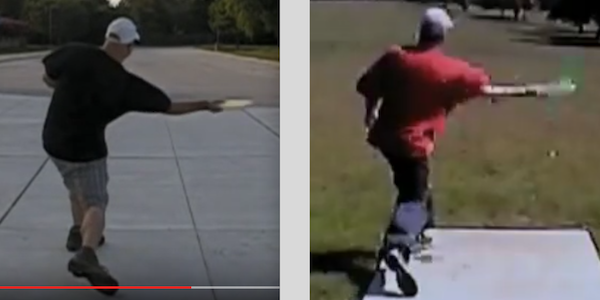
seedlings
* Ace Member *
In disc golf "elbow in" is a myth or t-rex arm as Scott Stokely calls it.
Exactly right. However the golf instructor was only commenting about the point of aim of the inside elbow. For disc golf, that elbow can be away from the body, but the aim is the same.
In disc golf "elbow in" is a myth or t-rex arm as Scott Stokely calls it.
Do correct me if I'm wrong, but I don't think 'elbow in' is taught because it's more powerful/efficient, it's taught because it reduces OAT, and leads to a cleaner release, more accuracy, and straighter shots. You can go to your local course and find plenty of former baseball players throwing FHs with an extended arm and blasting overstable distance drivers over 450 ft. But they can't throw any other shot shape or disc type. 'Elbow in' reduces the moving parts and makes it easier to throw without OAT, and gives you a much more versatile forehand, admittedly at the cost of efficiency and distance.
Of course, the ideal would be throwing smoothly with the extended arm, but that seems exceedingly difficult to do. Stokely seems like a real unicorn with his ability to throw that way, and I don't see his instruction leading to many others being able to do it.
- Joined
- Nov 2, 2008
- Messages
- 22,031
I don't know that there is a correct answer, there are a number of variables involved, and I was just saying it's a myth that you need to keep the elbow in. I think if you are swinging centrifugally it could be less moving parts and more repeatable. I used play baseball, never really had issues throwing understable discs or putters.Do correct me if I'm wrong, but I don't think 'elbow in' is taught because it's more powerful/efficient, it's taught because it reduces OAT, and leads to a cleaner release, more accuracy, and straighter shots. You can go to your local course and find plenty of former baseball players throwing FHs with an extended arm and blasting overstable distance drivers over 450 ft. But they can't throw any other shot shape or disc type. 'Elbow in' reduces the moving parts and makes it easier to throw without OAT, and gives you a much more versatile forehand, admittedly at the cost of efficiency and distance.
Of course, the ideal would be throwing smoothly with the extended arm, but that seems exceedingly difficult to do. Stokely seems like a real unicorn with his ability to throw that way, and I don't see his instruction leading to many others being able to do it.
https://www.youtube.com/watch?v=Ulp2RdqYSF8#t=1m14s
https://www.youtube.com/watch?v=--CCIxtDIxg&t=1m5s
I think the elbow in is less important compared to having the elbow bent with respect to the forearm to create that lag and then whipping motion. SW, your image above I think gives the wrong impression. I don't believe you, nor Stokely throw with a straight arm like a cricket bowler would do.
Similar threads
- Replies
- 16
- Views
- 2K
- Replies
- 81
- Views
- 6K
- Replies
- 4
- Views
- 963
- Replies
- 5
- Views
- 386
